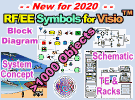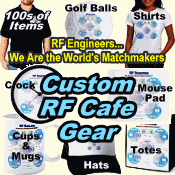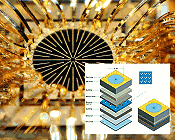Friday the 3rd
Thursday the 2nd
Wednesday the 1st
Tuesday the 30th
Monday the 29th
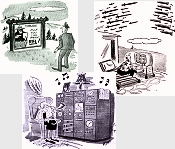 By
1970, the airwaves were really getting crowded. Lots of high power commercial
and military gear was online, and the radio listening public was setting new
record highs every year. As such, many new sources for
radio interference were being discovered, and sometimes the problems caused
went well beyond just a little noise being superimposed on top of Neil Diamond's
newly released Cracklin' Rosie or the lads from Liverpool's The Long and Winding
Road. Often, the interference was overwhelmingly annoying. The FCC was being
flooded with complaints. Digital computers were creating a whole new type of
electronic havoc, and leaky cable television cables and amplifiers caused all
kinds of headaches to over-the-air sets. Rusty bolts and chain link fences in
the vicinity of high power radio and TV towers - and even radar installations -
manifested themselves as detectors by virtue of their nonlinear nature. I
remember when people at Robins AFB, in Georgia, would sometimes complain to our
radar shop because their radios would blip once every four seconds as the search
radar antenna swept past their radios...
By
1970, the airwaves were really getting crowded. Lots of high power commercial
and military gear was online, and the radio listening public was setting new
record highs every year. As such, many new sources for
radio interference were being discovered, and sometimes the problems caused
went well beyond just a little noise being superimposed on top of Neil Diamond's
newly released Cracklin' Rosie or the lads from Liverpool's The Long and Winding
Road. Often, the interference was overwhelmingly annoying. The FCC was being
flooded with complaints. Digital computers were creating a whole new type of
electronic havoc, and leaky cable television cables and amplifiers caused all
kinds of headaches to over-the-air sets. Rusty bolts and chain link fences in
the vicinity of high power radio and TV towers - and even radar installations -
manifested themselves as detectors by virtue of their nonlinear nature. I
remember when people at Robins AFB, in Georgia, would sometimes complain to our
radar shop because their radios would blip once every four seconds as the search
radar antenna swept past their radios...
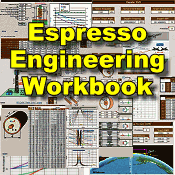 The newest release of RF Cafe's spreadsheet
(Excel) based engineering and science calculator is now available -
Espresso Engineering Workbook™. Among other additions, it now has a Butterworth
Bandpass Calculator, and a Highpass Filter Calculator that does not just gain, but
also phase and group delay! Since 2002,
the original Calculator Workbook has been available as a free download.
Continuing the tradition, RF Cafe Espresso Engineering Workbook™ is
also provided at no cost,
compliments of my generous sponsors. The original calculators are included, but
with a vastly expanded and improved user interface. Error-trapped user input cells
help prevent entry of invalid values. An extensive use of Visual Basic for Applications
(VBA) functions now do most of the heavy lifting with calculations, and facilitates
a wide user-selectable choice of units for voltage, frequency, speed, temperature,
power, wavelength, weight, etc. In fact, a full page of units conversion calculators
is included. A particularly handy feature is the ability to specify the the number
of significant digits to display. Drop-down menus are provided for convenience...
The newest release of RF Cafe's spreadsheet
(Excel) based engineering and science calculator is now available -
Espresso Engineering Workbook™. Among other additions, it now has a Butterworth
Bandpass Calculator, and a Highpass Filter Calculator that does not just gain, but
also phase and group delay! Since 2002,
the original Calculator Workbook has been available as a free download.
Continuing the tradition, RF Cafe Espresso Engineering Workbook™ is
also provided at no cost,
compliments of my generous sponsors. The original calculators are included, but
with a vastly expanded and improved user interface. Error-trapped user input cells
help prevent entry of invalid values. An extensive use of Visual Basic for Applications
(VBA) functions now do most of the heavy lifting with calculations, and facilitates
a wide user-selectable choice of units for voltage, frequency, speed, temperature,
power, wavelength, weight, etc. In fact, a full page of units conversion calculators
is included. A particularly handy feature is the ability to specify the the number
of significant digits to display. Drop-down menus are provided for convenience...
Friday the 26th
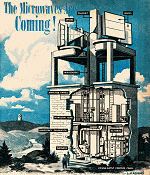 Decades ago, every
issue of Popular Science magazine was cram-packed with information on
just about every subject. Most of it was presented in news tidbit format with an
image and a short description. Some stories got a full page, and others, like
this one entitled, "The
Microwaves Are Coming," rated a multi-page spread. Unlike today's
communications systems where microwaves are ubiquitous, in 1949, the technology
was relatively new, having had its materials and methods greatly advanced during
the war years. Coaxial cable's use in high frequency communications was ramping
up at the same time. The Bell Telephone Company and Radio Corporation of America
(RCA) were key players in designing, installing, and operating microwave systems
for use in telephony, facsimile messaging, television, telegrams, radio mail
(early e-mail), and other services. Western Civilization that enabled the
innovation and implementation of such things is today used by agitators and
terrorists to rail against Western Civilization, whilst their ancestral lands
still mire in thatch huts and engage in human slavery...
Decades ago, every
issue of Popular Science magazine was cram-packed with information on
just about every subject. Most of it was presented in news tidbit format with an
image and a short description. Some stories got a full page, and others, like
this one entitled, "The
Microwaves Are Coming," rated a multi-page spread. Unlike today's
communications systems where microwaves are ubiquitous, in 1949, the technology
was relatively new, having had its materials and methods greatly advanced during
the war years. Coaxial cable's use in high frequency communications was ramping
up at the same time. The Bell Telephone Company and Radio Corporation of America
(RCA) were key players in designing, installing, and operating microwave systems
for use in telephony, facsimile messaging, television, telegrams, radio mail
(early e-mail), and other services. Western Civilization that enabled the
innovation and implementation of such things is today used by agitators and
terrorists to rail against Western Civilization, whilst their ancestral lands
still mire in thatch huts and engage in human slavery...
 If you had a father, brother, uncle, grandfather,
husband, or neighbor who was an electronics service technician in the days of yore,
he might have been mentioned in this 1958 issue of Radio & TV News magazine
highlighting General Electric's
Service technicians' All-American Award Winner. Rather than rewarding the independent
businessmen for their technical prowess, the company assigned awards based on community
services performed, thereby reflecting positively on both GE and the electronics
service business as a whole. Each winner received a $500 check, which in 2024 money
is the equivalent to about $5,400 (per the BLS) in today's economy. The closest
thing we have to the radio and television serviceman today is maybe the guys who
install broadband cable and satellite dishes. Their level of technical knowledge is
not required to be anywhere near as deep as their predecessors, though. Something
that always strikes me about photos from before about the 1960s is how sparsely...
If you had a father, brother, uncle, grandfather,
husband, or neighbor who was an electronics service technician in the days of yore,
he might have been mentioned in this 1958 issue of Radio & TV News magazine
highlighting General Electric's
Service technicians' All-American Award Winner. Rather than rewarding the independent
businessmen for their technical prowess, the company assigned awards based on community
services performed, thereby reflecting positively on both GE and the electronics
service business as a whole. Each winner received a $500 check, which in 2024 money
is the equivalent to about $5,400 (per the BLS) in today's economy. The closest
thing we have to the radio and television serviceman today is maybe the guys who
install broadband cable and satellite dishes. Their level of technical knowledge is
not required to be anywhere near as deep as their predecessors, though. Something
that always strikes me about photos from before about the 1960s is how sparsely...
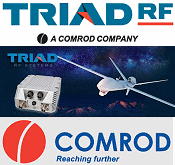 COMROD Communication AS (COMROD), has acquired
a majority share of
Triad RF Systems Inc. (Triad). The East Brunswick, New Jersey, USA company is
an innovative designer and manufacturer of RF/Microwave amplifiers and integrated
radio solutions for long-range RF communication in challenging environments including
defense applications and aerospace systems. The acquisition of Triad further positions
COMROD as a premier radio ancillary manufacturer that helps customers reach further
with cutting-edge technology. In addition to strengthening COMROD's RF
capability and capacity, the combined companies will be able to cooperate on
next-generation Radio Range Extension solutions. Triad's constant push to extend
the limits of data and distance...
COMROD Communication AS (COMROD), has acquired
a majority share of
Triad RF Systems Inc. (Triad). The East Brunswick, New Jersey, USA company is
an innovative designer and manufacturer of RF/Microwave amplifiers and integrated
radio solutions for long-range RF communication in challenging environments including
defense applications and aerospace systems. The acquisition of Triad further positions
COMROD as a premier radio ancillary manufacturer that helps customers reach further
with cutting-edge technology. In addition to strengthening COMROD's RF
capability and capacity, the combined companies will be able to cooperate on
next-generation Radio Range Extension solutions. Triad's constant push to extend
the limits of data and distance...
 •
Hertz Loses Another $200M from EVs
•
Hertz Loses Another $200M from EVs
• UK Government
Urged to Support 5G Rollouts
• Samsung
#1 in Q1 Smartphone Market
• Vodafone Idea Launches
$2.16B Share Sale
• Radio
Ink on a New Course
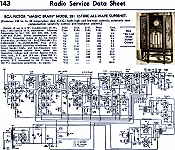 This Radio Service Data Sheet which appeared
in a 1935 issue of Radio-Craft provides schematics and parts lists for
RCA-Victor "Magic Brain" Model 281, 12-Tube All-Wave Superheterodyne receivers.
Most - if not all - electronics servicemen had subscriptions to these magazines
because they were a ready source of not just these service sheets, but because of
the extensive articles offering advice on servicing radios and televisions. In fact,
many electronics manufacturers had a policy of supplying service data only to bona
fide shops. A large list is included at the bottom of the page of similar documents
from vintage receiver schematics, troubleshooting tips, and alignment procedures...
This Radio Service Data Sheet which appeared
in a 1935 issue of Radio-Craft provides schematics and parts lists for
RCA-Victor "Magic Brain" Model 281, 12-Tube All-Wave Superheterodyne receivers.
Most - if not all - electronics servicemen had subscriptions to these magazines
because they were a ready source of not just these service sheets, but because of
the extensive articles offering advice on servicing radios and televisions. In fact,
many electronics manufacturers had a policy of supplying service data only to bona
fide shops. A large list is included at the bottom of the page of similar documents
from vintage receiver schematics, troubleshooting tips, and alignment procedures...
 Banner Ads are rotated in all locations
on the page! RF Cafe typically receives 8,000-15,000 visits each
weekday. RF Cafe
is a favorite of engineers, technicians, hobbyists, and students all over the world.
With more than 17,000 pages in the Google search index, RF Cafe returns in
favorable positions on many types of key searches, both for text and images.
Your Banner Ads are displayed on average 280,000 times per year! New content
is added on a daily basis, which keeps the major search engines interested enough
to spider it multiple times each day. Items added on the homepage often can be found
in a Google search within a few hours of being posted. If you need your company
news to be seen, RF Cafe is the place to be...
Banner Ads are rotated in all locations
on the page! RF Cafe typically receives 8,000-15,000 visits each
weekday. RF Cafe
is a favorite of engineers, technicians, hobbyists, and students all over the world.
With more than 17,000 pages in the Google search index, RF Cafe returns in
favorable positions on many types of key searches, both for text and images.
Your Banner Ads are displayed on average 280,000 times per year! New content
is added on a daily basis, which keeps the major search engines interested enough
to spider it multiple times each day. Items added on the homepage often can be found
in a Google search within a few hours of being posted. If you need your company
news to be seen, RF Cafe is the place to be...
Thursday the 25th
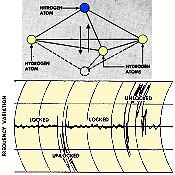 This report on America's first operational
atomic clock appeared in a 1949 issue of Popular Science magazine.
The National Bureau of Standards (NBS), now called the National Institute of Standards
and Technology (NIST), built an ammonia-based atomic clock which achieved the then
unheard of uncertainty of plus or minus one second every 300 years. NIST's current
atomic clock (NIST-F2) boasts an uncertainty of one second every 300 million years.
It uses caesium-133 as a reference. Other factors enabling the greater accuracy
is a more stable enclosure, high precision laser measurement, and cooling closer
to absolute zero. Of course if the atom ever did reach absolute zero, it would stop
vibrating and not be of much use - other than maybe as a direct current (DC) reference
;-
This report on America's first operational
atomic clock appeared in a 1949 issue of Popular Science magazine.
The National Bureau of Standards (NBS), now called the National Institute of Standards
and Technology (NIST), built an ammonia-based atomic clock which achieved the then
unheard of uncertainty of plus or minus one second every 300 years. NIST's current
atomic clock (NIST-F2) boasts an uncertainty of one second every 300 million years.
It uses caesium-133 as a reference. Other factors enabling the greater accuracy
is a more stable enclosure, high precision laser measurement, and cooling closer
to absolute zero. Of course if the atom ever did reach absolute zero, it would stop
vibrating and not be of much use - other than maybe as a direct current (DC) reference
;-
 Sam Benzacar, of Anatech Electronics, an
RF and microwave filter company, has published his April 2024 newsletter that, along
with timely news items, features his short op−ed entitled "Expanding
IoT Networks Pose Increased Security Risk," where he reports on the current
state of 5G and the Internet of Things (IoT) world. He says there are 20 million
IoT devices in service now and an expected 27 million by 2025 (that's next year,
believe it or not!). The movement from wired to wireless began with Bluetooth, WiFi,
cellular, and even ZigBee to some extent. 5G's stated goal is to have the capability
to totally obviate the need for wired interconnections, be it for telephones, computers,
security, home appliances, industrial controls, or any other entity needing real-time
communications with something else. Of course most equipment requires a separate
power supply from batteries (with or without dedicated solar cell array, wind generator,
etc.) or the electric power distribution system. Along with the freedom from wires
comes subjection to malicious infiltration to collect data and/or to control the
device or system. It is an unfortunate fact that there is always someone or some
group intent of corrupting and harming others...
Sam Benzacar, of Anatech Electronics, an
RF and microwave filter company, has published his April 2024 newsletter that, along
with timely news items, features his short op−ed entitled "Expanding
IoT Networks Pose Increased Security Risk," where he reports on the current
state of 5G and the Internet of Things (IoT) world. He says there are 20 million
IoT devices in service now and an expected 27 million by 2025 (that's next year,
believe it or not!). The movement from wired to wireless began with Bluetooth, WiFi,
cellular, and even ZigBee to some extent. 5G's stated goal is to have the capability
to totally obviate the need for wired interconnections, be it for telephones, computers,
security, home appliances, industrial controls, or any other entity needing real-time
communications with something else. Of course most equipment requires a separate
power supply from batteries (with or without dedicated solar cell array, wind generator,
etc.) or the electric power distribution system. Along with the freedom from wires
comes subjection to malicious infiltration to collect data and/or to control the
device or system. It is an unfortunate fact that there is always someone or some
group intent of corrupting and harming others...
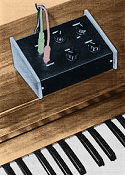 An RF Cafe visitor wrote to ask that I scan
and post this article on the
Leslie Effect Simulator, which appeared in a 1965 issue of Popular Electronics
magazine. "What the heck is the Leslie effect?" you are probably asking, as did
I. Basically, it is a mechanism for artificially creating the "wobbulating" effect
of a pipe organ in a large echoing environment. Inventor Donald Leslie worked for
the Hammond organ company and developed an electromechanical contraption that rotated
a baffle in front of speakers to create the effect. Commercial electronic Leslie
Effect products were sold back in the 1960s and 1970s when high fidelity (hifi)
stereo equipment was the "in" thing, like computers were in the 1990s and cellphones
are now. There were a lot of electronics hobbyists that loved to build projects
printed in magazines like Popular Electronics, especially since at the time many
things could be built more cheaply than buying a finished product off the store
shelf. Electric guitar players were big adopters of Leslie effect generators, and
were used by lots of top musicians. You can buy some of the vintage devices...
An RF Cafe visitor wrote to ask that I scan
and post this article on the
Leslie Effect Simulator, which appeared in a 1965 issue of Popular Electronics
magazine. "What the heck is the Leslie effect?" you are probably asking, as did
I. Basically, it is a mechanism for artificially creating the "wobbulating" effect
of a pipe organ in a large echoing environment. Inventor Donald Leslie worked for
the Hammond organ company and developed an electromechanical contraption that rotated
a baffle in front of speakers to create the effect. Commercial electronic Leslie
Effect products were sold back in the 1960s and 1970s when high fidelity (hifi)
stereo equipment was the "in" thing, like computers were in the 1990s and cellphones
are now. There were a lot of electronics hobbyists that loved to build projects
printed in magazines like Popular Electronics, especially since at the time many
things could be built more cheaply than buying a finished product off the store
shelf. Electric guitar players were big adopters of Leslie effect generators, and
were used by lots of top musicians. You can buy some of the vintage devices...
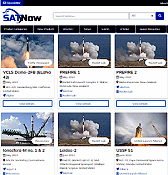 As a lifelong model rocketeer, I have always
been fascinated with watching rocket launches - whether full size or miniatures.
The SATNow website has an
aggregator page that reports upcoming launches of satellite-bearing rockets (and
keeps a history of past launches). These include NASA, Space X, Rocket, ISRO, Blue
Origin, and many more. The launch date, location (worldwide) and vehicle used are
provided for upcoming launches that have been publicly announced. Example for
VCLS Demo-2FB (ELaNa 43), Vandenberg SFB, CA, U.S.: "Firefly was selected by
NASA to provide launches services as part of our Venture Class Launch Services Demonstration
2 (VCLS Demo 2) contract. These launches can tolerate a higher level of risk than
larger missions, and they help demonstrate the capabilities of launch vehicles like
Alpha that support a new launch class and provide more access to space for small
satellites and spacecraft..."
As a lifelong model rocketeer, I have always
been fascinated with watching rocket launches - whether full size or miniatures.
The SATNow website has an
aggregator page that reports upcoming launches of satellite-bearing rockets (and
keeps a history of past launches). These include NASA, Space X, Rocket, ISRO, Blue
Origin, and many more. The launch date, location (worldwide) and vehicle used are
provided for upcoming launches that have been publicly announced. Example for
VCLS Demo-2FB (ELaNa 43), Vandenberg SFB, CA, U.S.: "Firefly was selected by
NASA to provide launches services as part of our Venture Class Launch Services Demonstration
2 (VCLS Demo 2) contract. These launches can tolerate a higher level of risk than
larger missions, and they help demonstrate the capabilities of launch vehicles like
Alpha that support a new launch class and provide more access to space for small
satellites and spacecraft..."
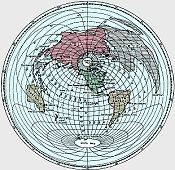 Before the Internet, cellphone apps, and
personal computers, many calculations began with a lookup table, chart, or nomograph.
In the case of long distance radio operators [Ham,
Short Wave Listener (SWL), and professional types] seeking distance and direction
information for pointing antennas, it took a map like this one published by Radio
News & Short-Wave magazine in 1934 to estimate an optimal configuration. Such
tools were essential in order to determine the best direction to point the antenna,
which over a long distance is usually much different than what might be assumed
by looking at a flattened projection map of the earth (see "Distance Lends Enchantment"
below). Distances in Chart No. 1 are all relative to New York, so operators
in other locales need to compensate...
Before the Internet, cellphone apps, and
personal computers, many calculations began with a lookup table, chart, or nomograph.
In the case of long distance radio operators [Ham,
Short Wave Listener (SWL), and professional types] seeking distance and direction
information for pointing antennas, it took a map like this one published by Radio
News & Short-Wave magazine in 1934 to estimate an optimal configuration. Such
tools were essential in order to determine the best direction to point the antenna,
which over a long distance is usually much different than what might be assumed
by looking at a flattened projection map of the earth (see "Distance Lends Enchantment"
below). Distances in Chart No. 1 are all relative to New York, so operators
in other locales need to compensate...
 One aspect of advertising on the RF Cafe
website I have not covered is using
Google AdSense.
The reason is that I never took the time to explore how - or even whether it is
possible - to target a specific website for displaying your banner ads. A couple
display opportunities have always been provided for Google Ads to display, but the
vast majority of advertising on RF Cafe is done via private advertisers. That is,
companies deal with me directly and I handle inserting their banner ads into the
html page code that randomly selects and displays them. My advertising scheme is
what the industry refers to as a "Tenancy Campaign," whereby a flat price per month
is paid regardless of number of impressions or clicks. It is the simplest format
and has seemed to work well for many companies. With nearly 4 million pageviews
per year for RFCafe.com, the average impression rate per banner ad is about 280k
per year (in eight locations on each page, with >17k pages)...
One aspect of advertising on the RF Cafe
website I have not covered is using
Google AdSense.
The reason is that I never took the time to explore how - or even whether it is
possible - to target a specific website for displaying your banner ads. A couple
display opportunities have always been provided for Google Ads to display, but the
vast majority of advertising on RF Cafe is done via private advertisers. That is,
companies deal with me directly and I handle inserting their banner ads into the
html page code that randomly selects and displays them. My advertising scheme is
what the industry refers to as a "Tenancy Campaign," whereby a flat price per month
is paid regardless of number of impressions or clicks. It is the simplest format
and has seemed to work well for many companies. With nearly 4 million pageviews
per year for RFCafe.com, the average impression rate per banner ad is about 280k
per year (in eight locations on each page, with >17k pages)...
Wednesday the 24th
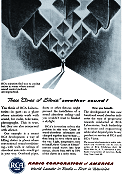 When most people of my era (born 1958) see
or hear something about a
Cone of Silence, they immediately think of the old Get Smart sitcom that ran
in the middle through late 1960s (we have the DVD set). Don Adams, aka Maxwell Smart,
aka Agent 86, and Barbara Feldon, aka Agent 99 (no name actually used),
were the top operatives within the good-guy international crime fighting organizations
known as CONTROL*. Their arch enemy was KAOS*. One of the gags used in the show
was the Cone of Silence, meant to ensure a conversation between two CONTROL agents
would not he heard by anyone else. The problem was that it never worked properly
and the people ended up yelling to each other and/or holding up handwritten notes
- both of which negated the need for a Cone of Silence. The users were most often
Max and The Chief. The Get Smart series was a spoof of James Bond and The Pink Panther...
When most people of my era (born 1958) see
or hear something about a
Cone of Silence, they immediately think of the old Get Smart sitcom that ran
in the middle through late 1960s (we have the DVD set). Don Adams, aka Maxwell Smart,
aka Agent 86, and Barbara Feldon, aka Agent 99 (no name actually used),
were the top operatives within the good-guy international crime fighting organizations
known as CONTROL*. Their arch enemy was KAOS*. One of the gags used in the show
was the Cone of Silence, meant to ensure a conversation between two CONTROL agents
would not he heard by anyone else. The problem was that it never worked properly
and the people ended up yelling to each other and/or holding up handwritten notes
- both of which negated the need for a Cone of Silence. The users were most often
Max and The Chief. The Get Smart series was a spoof of James Bond and The Pink Panther...
 In an electrical system, "how much?" is
asked about four quantities - current, voltage, resistance, and power. And four
kinds of
meters measure these quantities - ammeters, voltmeters, ohmmeters, and wattmeters.
Each meter's name indicates its use. Every conductor, every motor, every circuit
of any kind has a rated current load. Exceed this rated load and you ask for trouble
- heat develops, connections melt, and insulation burns. Ammeters tell you exactly
how much current is flowing - they forewarn you of overload. Each insulation has
a voltage rating. And 120-volt insulation will not stand 240 volts. It's like trying
to put 70 pounds of air pressure in a bicycle tire rated at 35 pounds. Something
lets loose. Motors are built to operate at a definite voltage of 110, 220, or 440
volts. If you try to operate a motor above or below its rated voltage, it either
"burns out" or gives such poor service that it's useless...
In an electrical system, "how much?" is
asked about four quantities - current, voltage, resistance, and power. And four
kinds of
meters measure these quantities - ammeters, voltmeters, ohmmeters, and wattmeters.
Each meter's name indicates its use. Every conductor, every motor, every circuit
of any kind has a rated current load. Exceed this rated load and you ask for trouble
- heat develops, connections melt, and insulation burns. Ammeters tell you exactly
how much current is flowing - they forewarn you of overload. Each insulation has
a voltage rating. And 120-volt insulation will not stand 240 volts. It's like trying
to put 70 pounds of air pressure in a bicycle tire rated at 35 pounds. Something
lets loose. Motors are built to operate at a definite voltage of 110, 220, or 440
volts. If you try to operate a motor above or below its rated voltage, it either
"burns out" or gives such poor service that it's useless...
 "Chasing ever-higher qubit counts in near-term
quantum computers constantly demands new feats of engineering. Among the troublesome
hurdles of this scaling-up race is refining how qubits are measured. Devices called
parametric amplifiers are traditionally used to do these measurements. But as the
name suggests, the device amplifies weak signals picked up from the qubits to conduct
the readout, which causes unwanted noise and can lead to
decoherence of the qubits if not protected by additional large components. More
importantly, the bulky size of the amplification chain becomes technically challenging
to work around as qubit counts increase in size-limited refrigerators. Bolometer-Based
Qubit Measurement Cue the Aalto University research group Quantum Computing and
Devices (QCD). They have a hefty track record of showing how thermal bolometers
can be used as ultrasensitive detectors, and they just demonstrated..."
"Chasing ever-higher qubit counts in near-term
quantum computers constantly demands new feats of engineering. Among the troublesome
hurdles of this scaling-up race is refining how qubits are measured. Devices called
parametric amplifiers are traditionally used to do these measurements. But as the
name suggests, the device amplifies weak signals picked up from the qubits to conduct
the readout, which causes unwanted noise and can lead to
decoherence of the qubits if not protected by additional large components. More
importantly, the bulky size of the amplification chain becomes technically challenging
to work around as qubit counts increase in size-limited refrigerators. Bolometer-Based
Qubit Measurement Cue the Aalto University research group Quantum Computing and
Devices (QCD). They have a hefty track record of showing how thermal bolometers
can be used as ultrasensitive detectors, and they just demonstrated..."
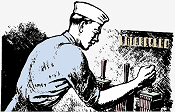 During the late 1700's and early 1800's,
three great electrical discoveries were made. An Italian, named Volta, discovered
how to produce an EMF from a primary cell. He gave his name to the measuring unit
of electromotive force - the VOLT. Ampere, a Frenchman, measured current flaw and
gave his name to the measuring unit of current - the AMPERE. A German, named Ohm,
measured the resistance of circuits and conductors and gave his name to the resistance
measuring unit - the OHM. Ohm did more than experiment with resistance - he connected
his own discoveries with those of Volta and Ampere. The result was
Ohm's Law. Make sure you understand each one of the three quantities in electricity
- they make up Ohm's Law. On the following page is a table of these important quantities,
their symbols, their units, their abbreviations, and their effects an a circuit...
During the late 1700's and early 1800's,
three great electrical discoveries were made. An Italian, named Volta, discovered
how to produce an EMF from a primary cell. He gave his name to the measuring unit
of electromotive force - the VOLT. Ampere, a Frenchman, measured current flaw and
gave his name to the measuring unit of current - the AMPERE. A German, named Ohm,
measured the resistance of circuits and conductors and gave his name to the resistance
measuring unit - the OHM. Ohm did more than experiment with resistance - he connected
his own discoveries with those of Volta and Ampere. The result was
Ohm's Law. Make sure you understand each one of the three quantities in electricity
- they make up Ohm's Law. On the following page is a table of these important quantities,
their symbols, their units, their abbreviations, and their effects an a circuit...
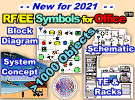 It was a lot of work, but I finally finished
a version of the "RF &
Electronics Schematic & Block Diagram Symbols"" that works well with Microsoft
Office™ programs Word™, Excel™, and Power Point™. This is an equivalent of the extensive
set of amplifier, mixer, filter, switch, connector, waveguide, digital, analog,
antenna, and other commonly used symbols for system block diagrams and schematics
created for Visio™. Each of the 1,000+ symbols was exported individually from Visio
in the EMF file format, then imported into Word on a Drawing Canvas. The EMF format
allows an image to be scaled up or down without becoming pixelated, so all the shapes
can be resized in a document and still look good. The imported symbols can also
be UnGrouped into their original constituent parts for editing...
It was a lot of work, but I finally finished
a version of the "RF &
Electronics Schematic & Block Diagram Symbols"" that works well with Microsoft
Office™ programs Word™, Excel™, and Power Point™. This is an equivalent of the extensive
set of amplifier, mixer, filter, switch, connector, waveguide, digital, analog,
antenna, and other commonly used symbols for system block diagrams and schematics
created for Visio™. Each of the 1,000+ symbols was exported individually from Visio
in the EMF file format, then imported into Word on a Drawing Canvas. The EMF format
allows an image to be scaled up or down without becoming pixelated, so all the shapes
can be resized in a document and still look good. The imported symbols can also
be UnGrouped into their original constituent parts for editing...
Tuesday the 23rd
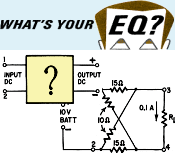 This newest "What's
Your EQ?" (Electronics Quotient) challenge appeared in the April 1967 issue
of Radio-Electronics magazine. It only has two circuits to work out. The first is
a fairly basic analysis problem where a voltage source and some resistors are connected.
You need to solve for the value of one resistor, given the current through it. As
it often the case, re-drawing the schematic to remove cross-connections clarifies
the situation and makes the task much simpler. The other problem is a black box
type, and it should not pose much of a problem. Not stated but implied is that the
diodes within are ideal and do not have a junction voltage drop (sorry for the spoiler,
but it really should have been included in the statement). Bon chance, viel Glück,
祝你好运, buena suerte, Удачи, καλή τύχη, がんばって, powodzenia, buona fortuna, and good
luck...
This newest "What's
Your EQ?" (Electronics Quotient) challenge appeared in the April 1967 issue
of Radio-Electronics magazine. It only has two circuits to work out. The first is
a fairly basic analysis problem where a voltage source and some resistors are connected.
You need to solve for the value of one resistor, given the current through it. As
it often the case, re-drawing the schematic to remove cross-connections clarifies
the situation and makes the task much simpler. The other problem is a black box
type, and it should not pose much of a problem. Not stated but implied is that the
diodes within are ideal and do not have a junction voltage drop (sorry for the spoiler,
but it really should have been included in the statement). Bon chance, viel Glück,
祝你好运, buena suerte, Удачи, καλή τύχη, がんばって, powodzenia, buona fortuna, and good
luck...
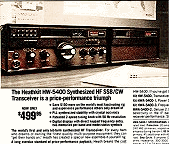 This good bit of personal insight into the
Heathkit
HW−5400 high frequency transceiver for Ham radio was offered by website visitor
Paul A., of Long Island, New York. Lots of Heathkit builders made modifications,
some necessary to achieve advertised performance, and others for improved performance.
Paul's efforts are quite impressive. I made the comment that since Heathkit products
were not built and tested in-house in large volumes, they did not have the benefit
of feedback on performance of systems and components that would otherwise be gained
from a production line. Prior to making new products available, Heathkit designers
had a number of fellow employees build the kits at home using parts and instructions
intended for customers. Changes were made based on that information, but that is
nowhere near the quality of feedback provided on an assembly line. He begins: "Back
in November of 2023 you had an article about the Heathkit HW5400. It included some
photos of an unbuilt kit. This brought back many memories. I'm the original owner
of an HW5400 that I purchased in 1985 from the Heathkit store in Northern Virginia.
I bought the transceiver, speaker/power supply, keypad and the accessory IF filter.
I had no idea what was in store for me! The transceiver worked the first time I
turned it on, but after putting it on the air, I began to get reports of distorted
or unnatural transmit audio. Thus began a two year long project to fix the bad audio..."
This good bit of personal insight into the
Heathkit
HW−5400 high frequency transceiver for Ham radio was offered by website visitor
Paul A., of Long Island, New York. Lots of Heathkit builders made modifications,
some necessary to achieve advertised performance, and others for improved performance.
Paul's efforts are quite impressive. I made the comment that since Heathkit products
were not built and tested in-house in large volumes, they did not have the benefit
of feedback on performance of systems and components that would otherwise be gained
from a production line. Prior to making new products available, Heathkit designers
had a number of fellow employees build the kits at home using parts and instructions
intended for customers. Changes were made based on that information, but that is
nowhere near the quality of feedback provided on an assembly line. He begins: "Back
in November of 2023 you had an article about the Heathkit HW5400. It included some
photos of an unbuilt kit. This brought back many memories. I'm the original owner
of an HW5400 that I purchased in 1985 from the Heathkit store in Northern Virginia.
I bought the transceiver, speaker/power supply, keypad and the accessory IF filter.
I had no idea what was in store for me! The transceiver worked the first time I
turned it on, but after putting it on the air, I began to get reports of distorted
or unnatural transmit audio. Thus began a two year long project to fix the bad audio..."
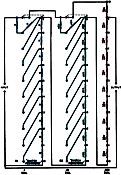 It took me a couple passes of the explanation
to comprehend the advantage of a Thomson-Varley (aka Kelvin-Varley, since Thomson
and Lord Kelvin are one and the same person)
switchable voltage divider compared to a standard type. At first I thought the
author, Edwin Bohr, was implying that the source and load impedances would not have
as great of an effect on the accuracy of the divider (and to some extent it is less
sensitive), but the main advantage is that the configuration permits simple cascading
stages of decade dividers to achieve essentially any degree of resolution. Both
a standard series-wired type voltage divider and the Thomson-Varley need ten resistors
and eleven switch positions to provide 10 equal steps (plus bypass). However, using
the same approach for 100 equal steps in the standard divider scheme would require
100 resistors, 1000 steps would require 1000 resistors, etc. The Thomson-Varley
divider cascades decades of dividers so that 100 equal divisions requires only 20
resistors, 1000 divisions requires 30 resistors, etc. Such a 'breakthrough' idea
was particularly significant in the days when large radial lead components and multi-layered
wafer switches that were point-to-point hand-wired were all that were available,
as compared to printed circuit boards that are automatically assembled with pick-and-place
robots today. Obtaining large quantities of precision resistors is a lot easier
nowadays as well. Metrology laboratories still use Thomson-Varley type voltage dividers
for equipment calibration...
It took me a couple passes of the explanation
to comprehend the advantage of a Thomson-Varley (aka Kelvin-Varley, since Thomson
and Lord Kelvin are one and the same person)
switchable voltage divider compared to a standard type. At first I thought the
author, Edwin Bohr, was implying that the source and load impedances would not have
as great of an effect on the accuracy of the divider (and to some extent it is less
sensitive), but the main advantage is that the configuration permits simple cascading
stages of decade dividers to achieve essentially any degree of resolution. Both
a standard series-wired type voltage divider and the Thomson-Varley need ten resistors
and eleven switch positions to provide 10 equal steps (plus bypass). However, using
the same approach for 100 equal steps in the standard divider scheme would require
100 resistors, 1000 steps would require 1000 resistors, etc. The Thomson-Varley
divider cascades decades of dividers so that 100 equal divisions requires only 20
resistors, 1000 divisions requires 30 resistors, etc. Such a 'breakthrough' idea
was particularly significant in the days when large radial lead components and multi-layered
wafer switches that were point-to-point hand-wired were all that were available,
as compared to printed circuit boards that are automatically assembled with pick-and-place
robots today. Obtaining large quantities of precision resistors is a lot easier
nowadays as well. Metrology laboratories still use Thomson-Varley type voltage dividers
for equipment calibration...
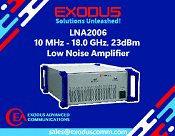 Exodus Advanced Communications, is a multinational
RF communication equipment and engineering service company serving both commercial
and government entities and their affiliates worldwide. We are pleased to offer
our
low-noise power amplifier for 10 MHz to 18.0 GHz. The LNA2006 produces
23 dBm (200 mW) power with 23 dB gain. A small class-A benchtop linear
design for optimum reliability & ruggedness for all EMC applications. Suitable
for all single channel modulation standards. Built-in protection circuits.
Exodus Advanced Communications, is a multinational
RF communication equipment and engineering service company serving both commercial
and government entities and their affiliates worldwide. We are pleased to offer
our
low-noise power amplifier for 10 MHz to 18.0 GHz. The LNA2006 produces
23 dBm (200 mW) power with 23 dB gain. A small class-A benchtop linear
design for optimum reliability & ruggedness for all EMC applications. Suitable
for all single channel modulation standards. Built-in protection circuits.
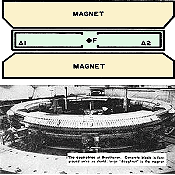 By 1957, when this article appeared in
Popular Electronics magazine,
betatrons, cyclotrons, cosmotrons, synchrocyclotron, bevatrons, and other forms
of "trons" had the physics world all agog with anticipation of the next big discovery.
Quarks were still a decade away from being discovered and something as exotic as
the Higgs boson (aka god particle) hadn't entered anyone's mind. The news media
was agog with reports of the world possibly coming to the end as a result of those
experiments sparking a nuclear reaction chain that would cause the whole world to
explode. Today, the news media is no smarter, because nowadays they fret over the
Large Hadron Collider (LHC) generating a black hole that will implode the whole
world. What a ship of fools...
By 1957, when this article appeared in
Popular Electronics magazine,
betatrons, cyclotrons, cosmotrons, synchrocyclotron, bevatrons, and other forms
of "trons" had the physics world all agog with anticipation of the next big discovery.
Quarks were still a decade away from being discovered and something as exotic as
the Higgs boson (aka god particle) hadn't entered anyone's mind. The news media
was agog with reports of the world possibly coming to the end as a result of those
experiments sparking a nuclear reaction chain that would cause the whole world to
explode. Today, the news media is no smarter, because nowadays they fret over the
Large Hadron Collider (LHC) generating a black hole that will implode the whole
world. What a ship of fools...
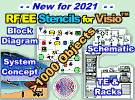 With more than 1000
custom-built stencils, this has got to be the most comprehensive set of
Visio Stencils
available for RF, analog, and digital system and schematic drawings! Every stencil
symbol has been built to fit proportionally on the included A-, B-, and C-size drawing
page templates (or use your own page if preferred). Components are provided for
system block diagrams, conceptual drawings, schematics, test equipment, racks, and
more. Page templates are provided with a preset scale (changeable) for a good presentation
that can incorporate all provided symbols...
With more than 1000
custom-built stencils, this has got to be the most comprehensive set of
Visio Stencils
available for RF, analog, and digital system and schematic drawings! Every stencil
symbol has been built to fit proportionally on the included A-, B-, and C-size drawing
page templates (or use your own page if preferred). Components are provided for
system block diagrams, conceptual drawings, schematics, test equipment, racks, and
more. Page templates are provided with a preset scale (changeable) for a good presentation
that can incorporate all provided symbols...
Monday the 22nd
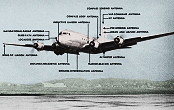 1949 wasn't all that long of a time since
airplane antennas consisted of a hundred feet or more of wire that was spooled
out in the air to trail behind the craft, servicing a CW type radio. The pilot tapped
out Morse code on a key strapped to his knee and wrote down the received code as
it came in. Prior to landing, the pilot wound the trailing wire antenna back in
- which sometimes was forgotten and got ripped off by trees. By the time World War II
came around, operating frequencies had moved up in the electromagnetic (EM) spectrum
and antennas were accordingly shortened. Still, a review of airplanes at the time
showed wire antennas strung from somewhere in the forward region of the airplane
(over or under the cockpit) or from the wingtip(s), back to the tip of the vertical
fin or tip of the horizontal stabilizer. That was all OK when airspeeds were south
of 200 mph or so, but higher speeds caused excessive drag in the air requiring
more rugged components, which added to weight. An exposed antenna also was subject
to risk of damage from ice, strikes by foreign objects, and oscillation. This
Popular Science article reports on some of the many advances made in embedding
antennas...
1949 wasn't all that long of a time since
airplane antennas consisted of a hundred feet or more of wire that was spooled
out in the air to trail behind the craft, servicing a CW type radio. The pilot tapped
out Morse code on a key strapped to his knee and wrote down the received code as
it came in. Prior to landing, the pilot wound the trailing wire antenna back in
- which sometimes was forgotten and got ripped off by trees. By the time World War II
came around, operating frequencies had moved up in the electromagnetic (EM) spectrum
and antennas were accordingly shortened. Still, a review of airplanes at the time
showed wire antennas strung from somewhere in the forward region of the airplane
(over or under the cockpit) or from the wingtip(s), back to the tip of the vertical
fin or tip of the horizontal stabilizer. That was all OK when airspeeds were south
of 200 mph or so, but higher speeds caused excessive drag in the air requiring
more rugged components, which added to weight. An exposed antenna also was subject
to risk of damage from ice, strikes by foreign objects, and oscillation. This
Popular Science article reports on some of the many advances made in embedding
antennas...
 • Today
Is
World Amateur Radio Day
• Today
Is
World Amateur Radio Day
• More
Small 5G Towers Reduce Network Energy Requirements
• FCC
to Online Retailers: Cease Selling Non-Secured IoT Devices
• How
AI Could Have Prevented the Key Bridge Collision
(or caused it)
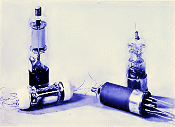 Who knew that the British General Post Office
was once in the vacuum tube development business? This 1957 article about the world's
first
transatlantic telephone line (TAT-1) mentions that the amplifier and frequency
equalizer repeater circuits and components for the Newfoundland and Nova Scotia
section of line was their responsibility. Bell Telephone Lab handled the deep-sea
portion of the system that ran between Newfoundland and Scotland. Everything was
designed to have at least a 20-year service-free lifespan. TAT-1 was inaugurated
September 25, 1956, and was decommissioned in 1978 without any technical failures
(although a trawler did snag the cable once, causing a brief outage), thus achieving
its designed longevity goal. An interesting solution was implemented to provide
the high voltage requirements of the equipment while avoiding excessive dielectric
thicknesses...
Who knew that the British General Post Office
was once in the vacuum tube development business? This 1957 article about the world's
first
transatlantic telephone line (TAT-1) mentions that the amplifier and frequency
equalizer repeater circuits and components for the Newfoundland and Nova Scotia
section of line was their responsibility. Bell Telephone Lab handled the deep-sea
portion of the system that ran between Newfoundland and Scotland. Everything was
designed to have at least a 20-year service-free lifespan. TAT-1 was inaugurated
September 25, 1956, and was decommissioned in 1978 without any technical failures
(although a trawler did snag the cable once, causing a brief outage), thus achieving
its designed longevity goal. An interesting solution was implemented to provide
the high voltage requirements of the equipment while avoiding excessive dielectric
thicknesses...
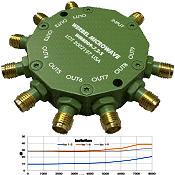 Werbel Microwave, one of the world's premier
RF and microwave components manufacturer, is proud to introduce the WM9RD-7.2-S,
a
9-way resistive power splitter / combiner that covers DC to 7.2 GHz with
ultra-wide bandwidth. This unique design accomplishes extremely flat frequency response
in a small radial package. Our unique design approach provides higher than expected
isolation between outputs at far ports than would be achieved in a typical star
topology (>28 dB between Groups A-B-C, see datasheet). It has applications
in markets such as CATV, test and measurement, and military radio. Its small size
makes it easy to integrate into compact systems. Designed, assembled, and tested
in the USA...
Werbel Microwave, one of the world's premier
RF and microwave components manufacturer, is proud to introduce the WM9RD-7.2-S,
a
9-way resistive power splitter / combiner that covers DC to 7.2 GHz with
ultra-wide bandwidth. This unique design accomplishes extremely flat frequency response
in a small radial package. Our unique design approach provides higher than expected
isolation between outputs at far ports than would be achieved in a typical star
topology (>28 dB between Groups A-B-C, see datasheet). It has applications
in markets such as CATV, test and measurement, and military radio. Its small size
makes it easy to integrate into compact systems. Designed, assembled, and tested
in the USA...
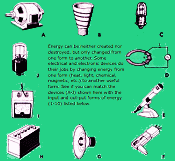 This quiz from a 1963 issue of Popular
Electronics magazine challenges (not too much, though) your knowledge of
energy conversion in common devices. A few of them might be unfamiliar to people
born after about 1990, but even so, you've probably seem them all at some point,
especially if you are a regular RF Cafe visitor (meaning you're probably smart).
It won't be giving anything away by telling you that item B is a heater that screws
into a light bulb socket, and item F is a phonograph stylus. Robert P. Balin
constructed many quizzes of this kind in the 1960s and 70s. A complete list of all
the Popular Electronics Quizzes is lower on this page...
This quiz from a 1963 issue of Popular
Electronics magazine challenges (not too much, though) your knowledge of
energy conversion in common devices. A few of them might be unfamiliar to people
born after about 1990, but even so, you've probably seem them all at some point,
especially if you are a regular RF Cafe visitor (meaning you're probably smart).
It won't be giving anything away by telling you that item B is a heater that screws
into a light bulb socket, and item F is a phonograph stylus. Robert P. Balin
constructed many quizzes of this kind in the 1960s and 70s. A complete list of all
the Popular Electronics Quizzes is lower on this page...
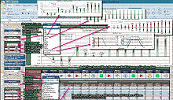 RF Cascade Workbook is the next phase in the evolution of RF Cafe's long-running
series, RF Cascade Workbook. Chances are you have never used a spreadsheet
quite like this (click
here for screen capture). It is a full-featured RF system cascade parameter
and frequency planner that includes filters and mixers for a mere $45. Built in
MS Excel, using RF Cascade Workbook is a cinch and the format
is entirely customizable. It is significantly easier and faster than using a multi-thousand
dollar simulator when a high level system analysis is all that is needed...
RF Cascade Workbook is the next phase in the evolution of RF Cafe's long-running
series, RF Cascade Workbook. Chances are you have never used a spreadsheet
quite like this (click
here for screen capture). It is a full-featured RF system cascade parameter
and frequency planner that includes filters and mixers for a mere $45. Built in
MS Excel, using RF Cascade Workbook is a cinch and the format
is entirely customizable. It is significantly easier and faster than using a multi-thousand
dollar simulator when a high level system analysis is all that is needed...
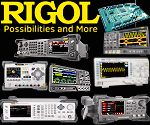 RIGOL Technologies is transforming the Test
and Measurement Industry. Our premium line of products includes digital and mixed
signal oscilloscopes, spectrum analyzers, function / arbitrary waveform generators,
programmable power supplies and loads, digital multimeters, data acquisition systems,
and application software. Our test solutions combine uncompromised product performance,
quality, and advanced product features; all delivered at extremely attractive price
points. This combination provides our customers with unprecedented value for their
investment, reduces their overall cost of test, and helps speed time to completion
of their designs or projects.
RIGOL Technologies is transforming the Test
and Measurement Industry. Our premium line of products includes digital and mixed
signal oscilloscopes, spectrum analyzers, function / arbitrary waveform generators,
programmable power supplies and loads, digital multimeters, data acquisition systems,
and application software. Our test solutions combine uncompromised product performance,
quality, and advanced product features; all delivered at extremely attractive price
points. This combination provides our customers with unprecedented value for their
investment, reduces their overall cost of test, and helps speed time to completion
of their designs or projects.




 COMROD Commun
COMROD Commun
























 RIGOL Technologies
RIGOL Technologies